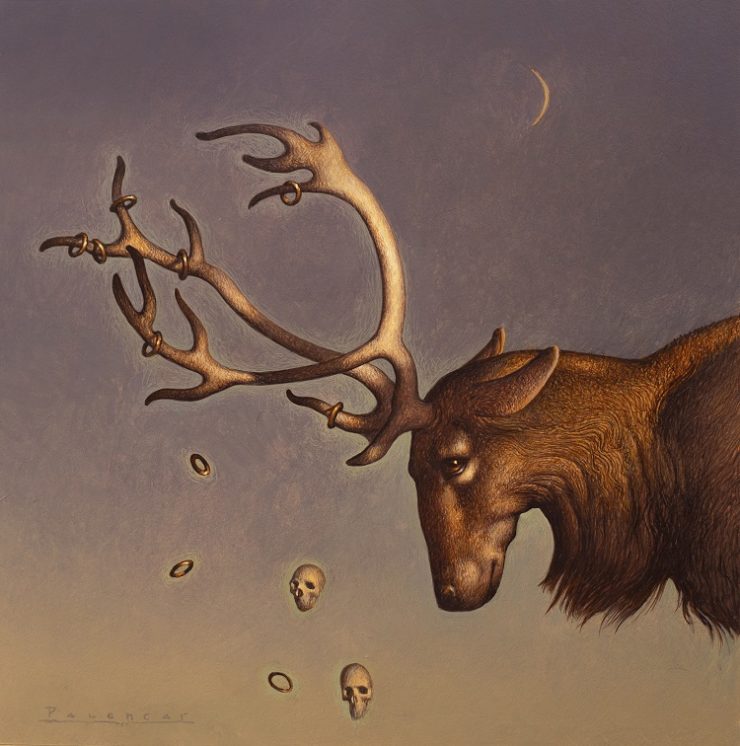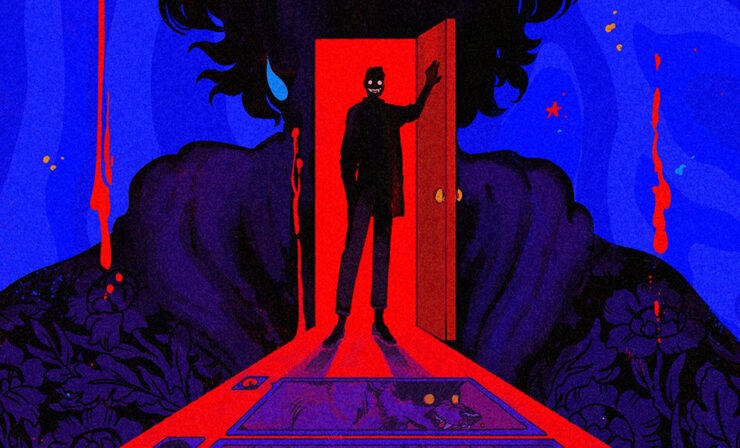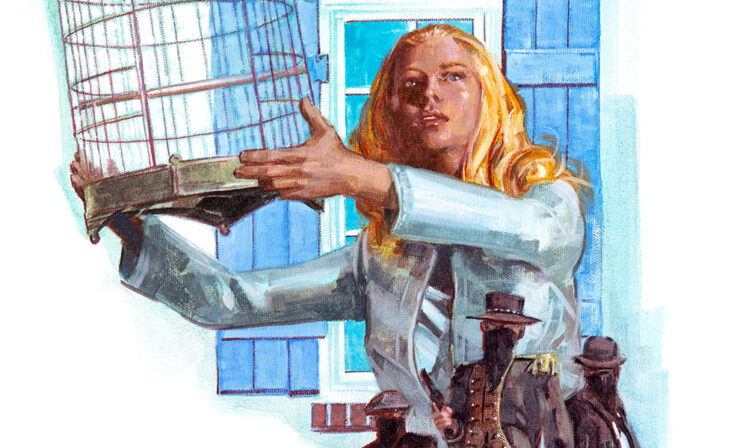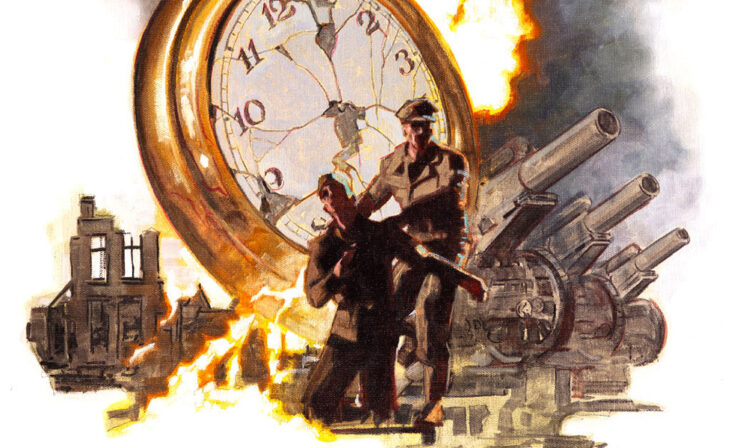In a fairy tale equal parts gorgeous and gruesome, village couples seek approval for marriage from a stag with golden rings adorning its horns. That is until one suitor, determined to convince a woman to fall in love with him, makes a rash decision.
Once, not so long ago, a marvellous stag lived in the forest at the foot of our mountain, on the other side of the little bridge you must still cross when you leave our village.
The stag was wily, and it was wise, but — most wonderful of all — its antlers were hung with golden rings. They gleamed in the sun and rang in the breeze, and cast spangles of light around him when he ran.
In those days, if someone on our mountain wished to be married, they would go out into the woods and hunt him. Such merry, mazy chases those were. At certain seasons parties of young people, youths and maidens alike, would gather laughing to trap him with linked hands and chains of flowers. At other times, solitary lovers would slip into the forest by the light of the golden moon, to seek the stag and offer silent petition.
Often enough, the desired rings were captured, or granted. But sometimes the stag and his bounty remained — forever, or a time — just out of reach. The villagers believed that to be advice, of a sort. Those who accepted it were in general happier than those who did not.
Where did the rings come from? That I cannot tell you, for no one knew. There were rumours, of course: that the rings fell like acorns from a tree deeper in the forest; that gentlefolk beyond the forest (a greater mystery to the villagers than enchanted stags) threw them at his antlers as we throw quoits at a peg. Others said that those who wished to dissolve a marriage would beg the stag’s indulgence and hang their own rings on its prongs in payment; that it dug the ornaments up from graves; that they grew from the antlers like velvet; that the stag itself was made of living gold.
That last is the rumour George-the-Wolf heard and believed.
Now, George-the-Wolf was not given that name for love. He was a sharp man with a starving look, like a wolf in winter, and like a wolf in winter he had his hungers: the greatest was to wed Red Elsie; the second was to become a man of account in the village. He was not, at that stage, the latter, and Red Elsie, who had her wisdom, would not have him.
But the more Red Elsie refused him, the more determined George-the-Wolf was to win her. She would not, of course, go courting in the forest, so he went alone to find the stag and demand its blessing. That, he thought, must persuade her to accept his suit.
He glimpsed it more than once: a glimmer of russet pelt and sloe-black eyes between alder and briar; a scramble of neat obsidian hooves on a mossy stone. A darting gleam like a dragonfly, or leaf-sun on a windy day, and always and often the ringing of gold, like tiny bells. But he could never catch up with it.
Exhausted and furious, George would return from the hunt, and curse bitterly the lovers who went that spring to the woods. Out they walked, singing, and back they came smiling and beringed, and all the while, George-the-Wolf knew that Red Elsie knew he had failed.
His bread tasted dry; his beer sour; his work — such as it was — brought him no satisfaction. If only he had a great house, with five rooms or more, and bright tiled stoves, and hirelings to fetch and carry, then (he told himself) he would be satisfied. Red Elsie, wise and superior as she was, would wish for nothing better than his hand, and perhaps he would make her wait on his condescension.
Then one long evening, as a laughing couple ran past his door, George-the-Wolf made a plan. He took up his hunting knife, slipped out the door, and followed the couple silently down the mountain, and over the bridge, and into the trees. They walked a long way, and at last they sat down in the lee of some boulders at the edge of a glade, and fell to conversing as lovers will. George hid behind one of the stones.
If the courting couple heard anything in the purpling twilight of the forest, they only glanced about eagerly for the stag. And in time, at last, with the innocent curiosity of a wild thing which knows itself rare and precious in the world, the creature appeared. It picked its way into the glade before the boulders, the soft-chiming rings shining in the new starlight.
The lovers, entwined, lay breathless, waiting. George-the-Wolf held still, too, but he gathered his strength.
Buy the Book
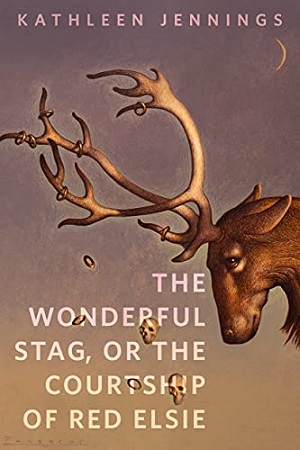

The Wonderful Stag, or The Courtship of Red Elsie
Carelessly, idly, with — one might guess — amusement glinting in its deep dark eyes, the stag nosed its way towards the couple until, at last, it lowered its head — and its antlers — towards the outstretched hand of the bride.
Then George-the-Wolf, with his long knife flashing, leapt.
The lovers fled.
His work was swift and bloody, and when it was finished George-the-Wolf was alone. He stripped the gold from the antlers of the dead beast, and hacked them free of its skull, and then slit its carcass open — throat and belly. He was looking for the gold that must be there, or the mechanism that had driven the stag or, at last, some sign or retribution from a world that had allowed such wonders to taunt him. But he found only its pink-frothed lights, the slick ropey coils of intestines, the pearly sack of its stomach, the clenched muscle of its heart. No gold, and no miracles.
Sticky and stiff with drying blood, his pockets barely weighted by the handful of rings he had harvested, George-the-Wolf went back to the village. Red Elsie would have him now, he told himself. He held all the remaining happiness of the village. Who would marry without his say-so? Who could refuse him? The gold itself would fetch a little, should he choose to sell it, but the feat — surely that in itself would make him remarkable. They would call him The Wolf in truth. He bared his teeth in the darkness, and snarled with what he thought was happiness.
But the lovers were ahead of him. When he returned, the village was waiting, and in the square, a fire had been built of all he owned. Red Elsie stood in front of it.
“Burn him, too,” whispered the villagers, the lovers, the youths who had only just grown to adulthood and begun to turn their thoughts to the forest, the old couples who had followed the stag in their long-remembered day. “Burn the Wolf,” they said, and then they shouted, “To the flames!”
But when they had laid hands on him, Red Elsie said, “No.”
Just a word, but they all listened. Even George-the-Wolf.
“No,” she said. “What will that profit us, or him? If this terrible thing is true, let us go and see it with our own eyes and then — let the punishment be fitting. Fire is for fleas, not for huntsmen.”
“Fire is for witches,” spat George-the-Wolf, who did not want them to see what he had left in the clearing. “If anything you should thank me! Why should we be held in thrall to a monster? As for your mercy — that is for those who have done wrong.”
“I did not speak of mercy,” said Red Elsie.
The villagers lit torches against the night. They wended their way down from the village, over the footbridge, and into the forest. Red Elsie, who held no torch, led the way as if she could smell out the stag’s blood, as if her own long shadow ahead of her was the finger of fate. The lovers whose courtship had been so terribly ended stumbled along with her. And in the centre of the pack, arms bound, was marched George-the-Wolf.
It was a long walk to the glade where the stag lay, ghastly and ungilded. Its head was arched back on its gaping throat, its entrails unspooled from its hide, its long lovely limbs sprawled over the bloodied grass. The antlers were cut about from George’s frantic search for budding gold.
“Let us slit his neck as he slit the stag’s; let us open him and unwind his inner parts,” said the villagers. “Let us bury him with its corpse.”
“No,” said Elsie. “Who will gain from that?” Her teeth were bright in the flames of the torches. “You, with his knife, take off the stag’s hide; and you, with the threads and needles in your apron-pocket, put that hide on George-the-Wolf; and you, with your earrings and your bracelets, and all who would be rid of their rings for a time, fill his belly with them, and with those he has stolen, until he can hold no more.”
He fought and snarled, gagged, and wept, and screamed. But the village did not relent, until, throat ripped raw and belly stretched and sagging, George-the-Wolf was stitched and knotted, entire, into the stag’s red skin. The heavy head lolled on his, and the gaping throat was sewn shut over his mouth and nose and, finally, his eyes.
“Are there wolves in the wood at this time of the year?” asked one of the lovers, although that thought had not troubled them earlier in the evening. “Real wolves?” asked the other.
And Red Elsie, with a shrug in her voice (and George-the-Wolf, listening through his own heartbeat, and the thick wet hide, and the night, heard it), said, “If there are, he had better learn to run.”
The villagers left, taking the last spangle of torchlight, which had shone through the stitching like red gold. Night settled behind them, chilling the unscraped flesh-side of the stag’s skin as it clung clammily to George’s. There was scuffling in the grass, and a whimper — perhaps it was a man’s — and a cry in the night, and George stumbled to feet, to hooves, and staggered into the trees.
Those who wish to wed in the village now must walk a long way, down from the mountains and into the valley with its towns and river-trade and schools. They must go swiftly, and they will not travel at night, for there is still a creature in the forest with hooves and a pelt the colour of old blood, and rings on its antlers. It is an angry, dangerous, graceless beast, and it has killed travellers and petitioners both before now, and trampled them, and taken their gold.
But if lovers wish to marry the old way, and not bow to the inquiries and iniquities of magistrates in cold, pillared courthouses, they may still go hunting in the forest. If they can trap it, and hold a knife to its throat, they might wrest a ring from those terrible antlers — more bone than horn, and with tin and silver and fools-gold growing mingled through the prongs.
Those rings will not necessarily grant such lovers happiness, as it is said the old ones did. And if you wish to be freed from your marriage, it is safer, all in all, to ask the permission of Red Elsie, and accept her terms.
Buy the Book


The Wonderful Stag, or The Courtship of Red Elsie
“The Wonderful Stag, or The Courtship of Red Elsie” Copyright © 2021 by Kathleen Jennings
Art copyright © 2021 by John Jude Palencar










